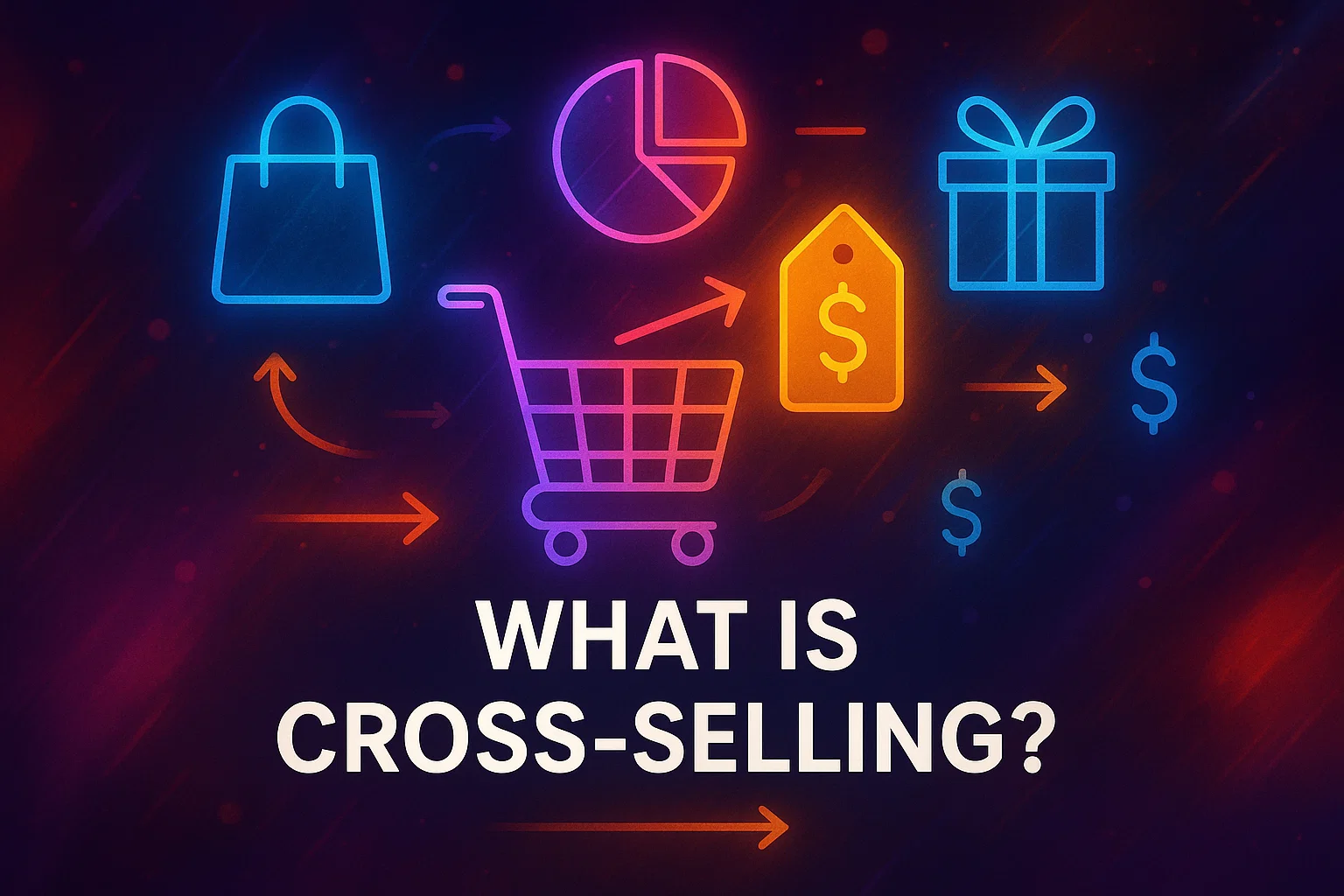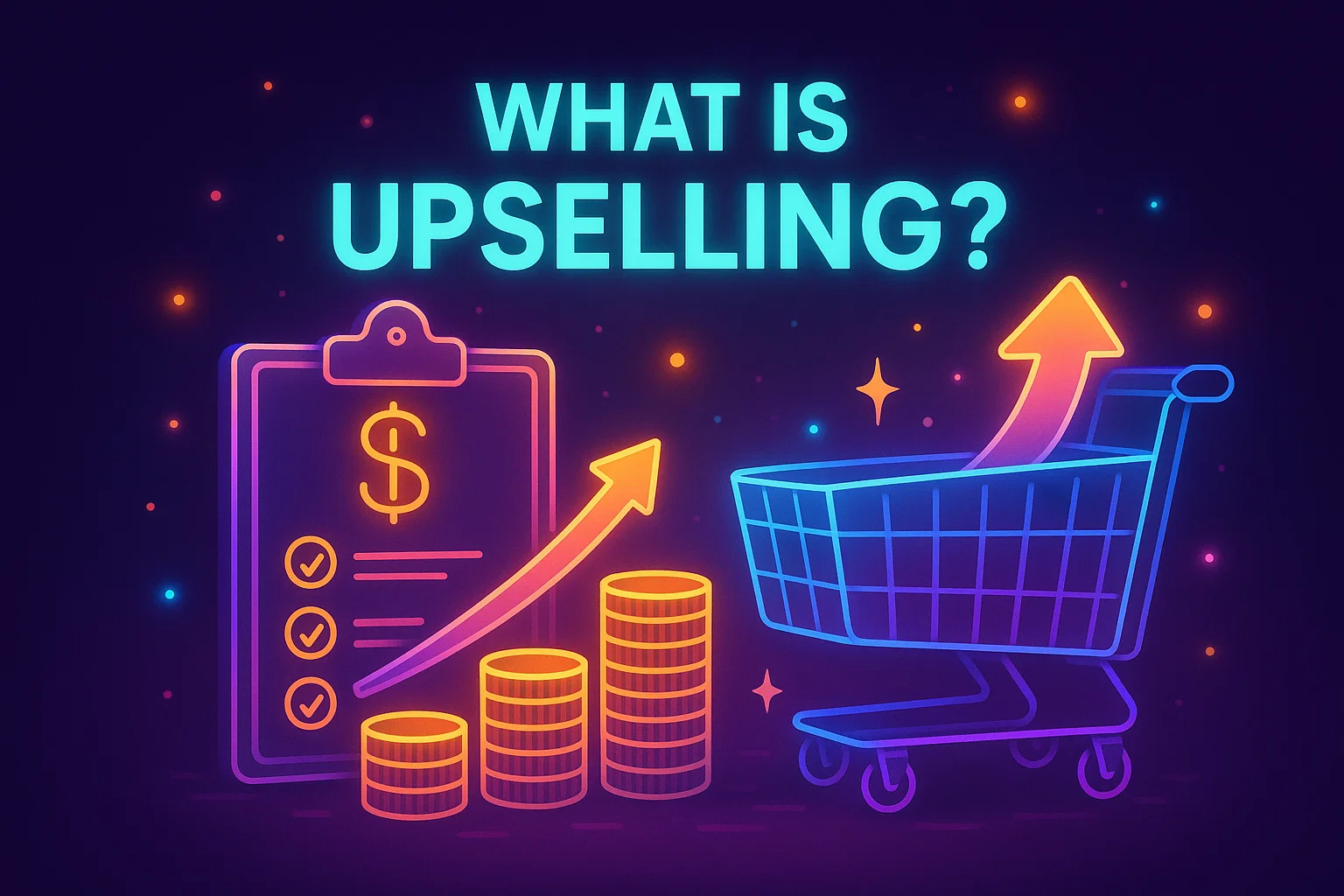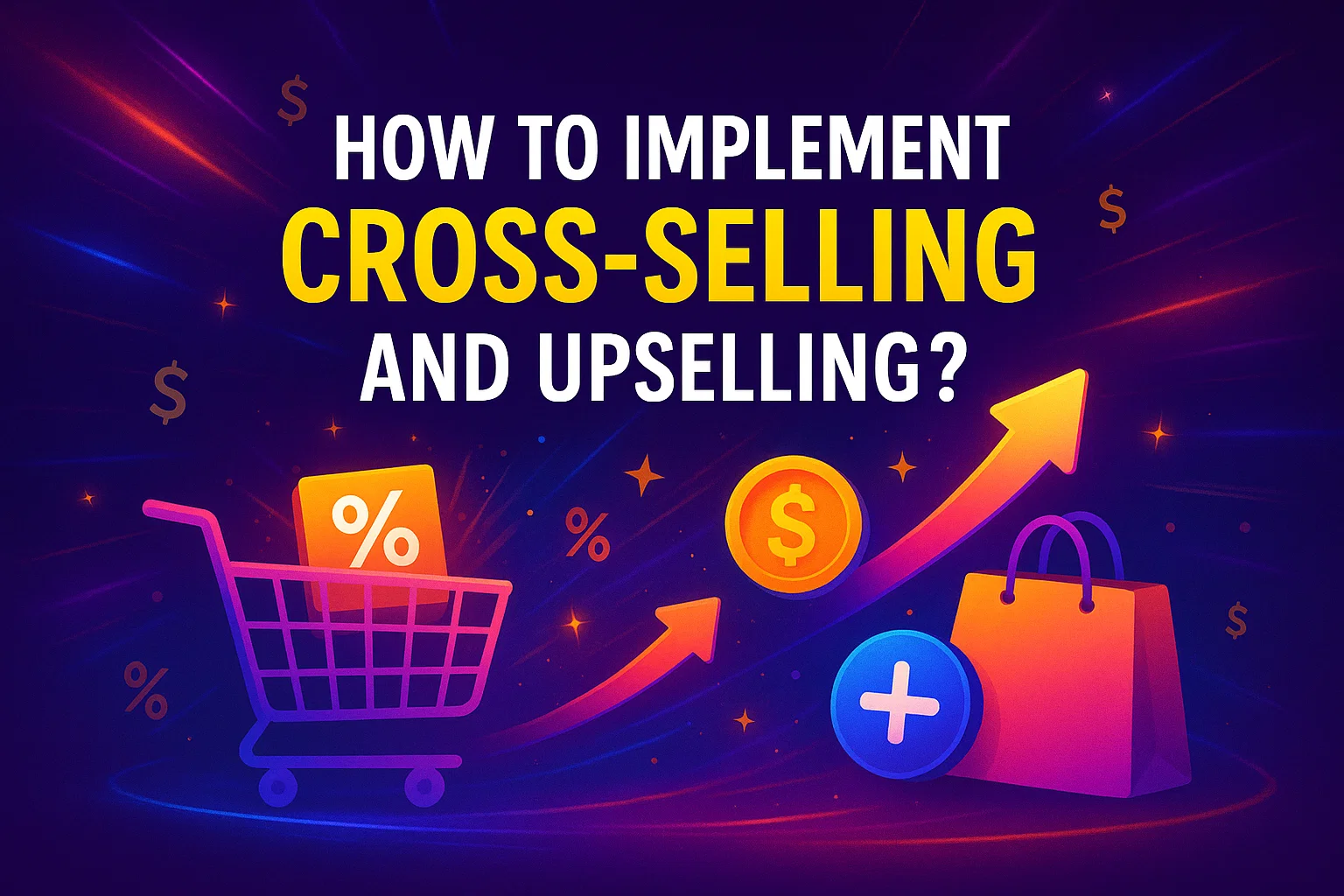Suppose you’re shopping for a new laptop online. As you’re checking out, you find a pop-up shows up, suggesting an external hard drive with your new laptop purchase. That’s called cross-selling. In another case, if you find a recommendation to buy a higher-spec laptop, with a bigger screen and more memory, it is an upsell.
Both of the business strategies are designed to increase sales, but they differ in how they work.
Cross-selling involves recommending complementary products, while upselling encourages customers to purchase a upgraded version
As businesses are already boosting revenue by 20% and profits by 30% through cross-selling and upselling, it’s important to have a better understanding of how these two methods work. In this article, we’ll explore the acutal differences between these and how businesses can use them to improve sales.

What is Cross-Selling?
Cross-selling is an effective sales strategy used in business to recommend complementary products to what they’re already buying. The only motive here is to make their purchasing experience even better by suggesting more likely add-ons with the main item.
For example, if a customer is purchasing a digital camera, the thought of cross-selling is to recommend a memory card, camera bag, or tripod. These items will support the main product and also help the customer get the most out of their new camera.
In short, cross-selling helps the customers to get everything they need in one place, which also increases the sales for the business, leading to higher revenue growth.
Importance of Cross-Selling in Business
Cross-selling is the smartest way to reach out to the ultimate customer satisfaction level and ensure long-term brand value. When the business can suggest extra items that go well with what a customer is already buying, it is likely adding value to their purchasing experience. It not only increases the total order amount but also helps to build an understanding of what the customer exactly wants, and by fulfilling those, they can build trust among them.
If everything goes well, cross-selling leads to higher conversion rates. It is because businesses can offer better, helpful and related products rightawayy without making them with random options. It helps customer to really come back again and again, resulting in an increased their revenue streams. Research shows that cross-selling accounts for over 35% of Amazon’s total sales.
With the right strategies, businesses can create smarter sales plans that are easy on the customer’s preferences and improve the overall shopping experience.

What is Upselling?
Upselling is an effective sales technique that helps customers find better versions of the product they’re already thinking about. It is done by motivating them to choose a higher-priced item that offers more value. It includes better features, improved quality, or having extra benefits.
For example, if a customer is booking a standard hotel room. While doing so, the booking platform might recommend upgrading to a deluxe suite with a sea view, complimentary breakfast, and late checkout. This is what the upselling technique is, which improves the guest’s experience while increasing the total booking value for the hotel.
The key is offering helpful suggestions. It must not be unnecessary options or something that is not related to the main product. It is about helping the customer to find a smarter option that improves their overall experience.
Importance of Upselling in Business
Upselling is a result-driven strategy for business that directly influences customers to choose higher-quality products with more value. With the better alternatives, businesses can easily increase revenue and improve the customer satisfaction level.
This approach not only boosts the average order value but also helps businesses build stronger customer relationships. As you are presenting options that go more closely with the customer’s needs, you can easily achieve their ultimate trust in them.
If everything goes well, upselling can lead to higher profit margins and improved brand loyalty. According to a survey, about 70–95% of revenue from subscription businesses comes from upsells and renewals.
Cross Selling vs. Upselling: The Main Differences
Though both cross-selling and upselling are designed to increase revenue, they differ in approach and execution.
Here’s a breakdown of the key differences:
- Focus: Cross-selling recommends complementary products that are based on the customer’s preference. In contrast, upselling encourages customers to buy a more expensive version of the same product with improved features, better performance, or added benefits.
- Objective: The core objective of cross-selling is to increase the order amount by meeting the related needs. While, upselling works to maximize the value of a single purchase by offering a product.
- Customer Experience: Cross-selling expands the range of products a customer purchases. Whereas, upselling encourages customers to spend more on a premium version of the product they’re already considering.
- Timing: Cross-selling is typically applied after the purchase or at checkout, while, upselling takes place when the customer is deciding on the initial product.
Cross-Selling vs. Upselling – Key Industries
Cross-selling is mostly used in retail, e-commerce, and financial services to offer related products. On the contrary, upselling is common in technology, hospitality, and automotive industries to promote higher-value options.
Each industry utilizes these techniques in unique ways to best accommodate its business model. Here’s how cross-selling and upselling are used in key industries:
1. E-commerce
- Cross-Selling: E-commerce stores use product recommendations to suggest related items during or after the checkout process. For example, if you’re buying a smartphone, you might find other accessory suggestions such as protective cases, wireless earbuds, or screen protectors here with it.
- Upselling: E-commerce platforms utilize the upsell strategy and offer higher-tier versions of the same product. A shopper might start browsing with the basic laptop only. But with the upselling method, you can turn their mind to a model with better specifications, such as a larger screen or more storage. All in all, they are staying within the same product category but raising the purchase value.
2. Retail
- Cross-Selling: In retail stores, the appropriate product placement is the key. Through cross-selling, businesses can easily place and organize the related items when next to each other. For example, a customer is buying a camera. Right after that, you can show memory cards, camera bags, or tripods in the products list that naturally match with the camera.
- Upselling: Retailers upsell by presenting a higher-end version of a product. For example, if you’re interested in a refrigerator, the store might suggest a premium model with better energy efficiency or extra features.
3. Travel & Hospitality
- Cross-Selling: In travel, companies cross-sell by offering add-ons like car rentals, guided tours, or vacation packages when a customer books a flight or hotel room. These additional offerings are designed to enhance the trip experience and make the users ultimately satisfied with the service.
- Upselling: If the fact is about upselling in travel, it is mostly used to upgrade the customer’s experience. For instance, while booking, businesses can offer class tickets instead of economy, or a luxury hotel suite instead of a standard room.
4. Software & SaaS
- Cross-Selling: Software companies often need to offer related features or services after the customer purchases the basic version, and that’s what point cross-selling stands out. For example, after buying a software program, you might find that the company is suggesting extra storage, additional integrations, or advanced features.
- Upselling: Upselling in SaaS companies is helpful to move a customer from a basic plan to a professional or enterprise tier. Higher plans often include more advanced features, additional users, better analytics, or automation tools.

How to Implement Cross-Selling and Upselling?
To implement cross-selling, suggest related products or services during the purchase process or afterward. And for implementing upselling, you will have to offer customers higher-value or upgraded options.
Here are the complete details you should know about:
For Cross-Selling:
- Know Your Products: Before you make any suggestions, all you need is a better understanding of how your products connect. Find:
- Complementary products frequently purchased together
- Useful add-ons to improve the use of a primary product
- Accessory items for better functionality
- Use Data to Personalize Offers: Next, you need to utilize the customer data, such as past purchases, browsing history, or demographics. It is needed to offer more personalized product suggestions that best fit their needs.
Personalized product recommendations can increase conversion rates by up to 70% compared to the generic ones. You can use analytics and CRM tools to track the relevant data.
- Integrate Cross-Selling Into the Shopping Process: Now is the time to show related products. Identify the right moments when the customer makes a purchase. Place relevant suggestions at high-impact touchpoints.
For instance:
- Product Detail Page: “Frequently bought together” or “You may also like” sections
- Shopping Cart: Add related items before checkout
- Checkout Page: Offer last-minute add-ons or bundles
- Post-Purchase Emails: Suggest useful items that complement the customer’s recent purchase
- Offer Bundles or Discounts: You can offer a discount when customers purchase a bundle of complementary items. Also, you can create product kits or packages that are customized to specific use cases.
Example: “Buy a laptop and get 20% off a wireless mouse and laptop sleeve.”
- Make It Convenient: Ensure the suggested cross-sells are easy to add to the cart with a simple click or a “one-click” purchase option. Suggest a product with clear pricing and benefits. There should not be any additional steps or disruptions in the checkout process.
For Upselling:
- Identify the Right Moments: In upselling, the right moment is key. You need to find out the exact moment when customers are actively engaged in the buying process or browsing for similar products.
- Focus on Value: Customers always show interest in updating their purchase if it adds value over their chosen one. For this, you can focus on how the premium option improves the user’s experience rather than only suggesting the expensive product. Like, you can offer products with better durability, improved performance, faster service, or access to exclusive features.
- Create Clear Comparisons: With many more product recommendations, your customer may get a bit confused. In this case, you can show a side-by-side comparison of the original product and the premium option. It would help them identify the differences in value.
- Use Limited-Time Offers: With the upselling suggestion, you can create a sense of urgency with limited-time promotions. It motivates customers to make the right decision quickly.
- Train Your Team: Ensure your sales team is knowledgeable enough to know and describe the product features to the customer. If any problem arises, they should be active to attend to it right away.
Common Mistakes to Avoid in Cross-Selling and Upselling
Some of the common mistakes in cross-selling and upselling that must be avoided are ignoring customers’ preferences, proceeding to them at the wrong time, offering irrelevant products, overwhelming the customer with too many choices, avoiding personalized options, and so on.
Avoiding these common errors will help you optimize your sales approach:
1. Overwhelming the Customer
Too many choices on the same product list can easily overwhelm the customers. It can easily confuse customers and make them second-guess their decision. Limit your suggestions to 1–3 products that exactly complement the customer’s selection.
2. Focusing Only on the Sale
Though the only motive of cross-selling and upselling is to increase sales, you need to work on enhancing the customer experience as well. With them just offering more expensive products or add-ons without considering what the customer needs or wants, it creates frustration. Prioritize offering products that add real value to the customer’s purchase.
3. Ignoring Customer Preferences
Not all customers are the same. So, if you skip customer preferences and previous purchase history, it can make your recommendations feel irrelevant. As a robust solution, use data and insights to personalize the suggestions for each customer.
4. Being Too Aggressive
If you try too hard to sell more, it can turn customers away. Forcefully applying tactics can feel annoying and make shoppers less likely to buy anything at all. Instead, cross-selling should feel like helpful suggestions. An overly aggressive approach can create a negative experience. Ensure your approach feels natural. Use friendly messages like “You might also like…”. Customers decide without pressure.
5. Not Timing It Right
Timing has a big part in cross-selling and upselling. If you offer upsells too early, or before the customer has committed to a purchase, it can turn them off. Likewise, offering cross-sells too late in the process, after the customer has already made their decision, can miss an opportunity. The best time to upsell is when your customer is comparing products. For cross-sells, recommend options during checkout.
6. Failing to Test and Optimize
Another big mistake the business often makes is using the same upselling strategy for every product. It is natural that what helps increase sales for one item may not work for another. Every business and customer base is different. That’s what points to testing different cross-selling and upselling techniques as important. Continuously optimize your approach based on performance data and feedback.
How to Measure Success in Cross-Selling and Upselling?
To ensure your cross-selling and upselling strategies are effective, you need to track key performance metrics and adjust your strategies accordingly.
Here are the key metrics to measure success:
1. Average Order Value (AOV)
AOV is an effective metric through which you can measure how much a customer spends per order. If your cross-selling and upselling strategies are working, this number should increase over time. In case AOV is declining, it may indicate that customers are ignoring your recommendations or not finding them valuable.
How to Measure:
AOV = Total Revenue ÷ Number of Orders.
2. Conversion Rate
This metric tracks the percentage of customers who accept your cross-sell or upsell offers. A higher conversion rate means your suggestions are running well. Besides, a low conversion rate might indicate that the offers aren’t relevant or appealing.
How to Measure:
Conversion Rate = (Number of Accepted Offers ÷ Total Offer Opportunities) × 100
3. Customer Lifetime Value (CLV)
CLV helps determine the total revenue a customer generates over time. Successful cross-selling and upselling should increase CLV by encouraging repeat purchases. A low CLV means customers aren’t engaging beyond their initial purchase.
How to Measure:
CLV = AOV × Purchase Frequency × Customer Lifespan
4. Attach Rate
This metric tracks how often customers add recommended products to their cart. A higher attach rate indicates strong product recommendations. A lower attach rate is a clear sign that suggestions are irrelevant or poorly placed.
How to Measure:
Attach Rate = (Total Number of Cross-Sold/Upsold Items ÷ Total Transactions) × 100
5. Revenue Growth from Cross-Selling & Upselling
The metric tracks the total revenue directly generated from cross-selling and upselling activities. With the growing percentage of revenue, you can rest assured that you are growing with the right strategies. Tracking the direct revenue contribution from these strategies helps assess their impact on your overall sales.
How to Measure:
Compare revenue before and after implementing cross-selling and upselling campaigns.
6. Customer Satisfaction & Retention
If done correctly, cross-selling and upselling should enhance customer experience. You need to track customer feedback and repeat purchase rates to find whether your strategy is adding value. High satisfaction scores and retention rates indicate that customers find your offers helpful and value-adding
How to Measure:
Use post-purchase surveys, reviews, and Net Promoter Scores (NPS).
Final Thoughts
Both cross-selling and upselling are essential strategies for boosting sales, enhancing customer experience, and maximizing revenue. The key to success lies in offering relevant, well-timed, and value-driven recommendations that truly benefit the customer.
By implementing the right strategies, avoiding common mistakes, and measuring key performance metrics, businesses can utilize these techniques. It drives sustainable growth and long-term customer loyalty.
Author
Shirikant is a proven customer success leader who combines sharp business insight with practical experience to improve retention and drive revenue. As the founder of Statwide, he designs customer-first business strategies that guide companies to turn users into loyal and long-term partners. His approaches are built on real results: stronger relationships, higher customer value, and lasting growth.








